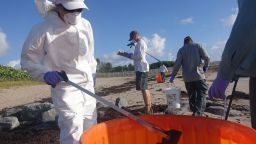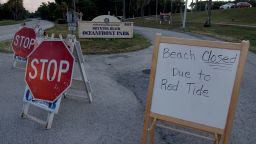The red tide bloom that’s been in the waters off Florida’s Gulf Coast for months is now choking the state’s Atlantic waters from Miami Beach to Palm Beach.
Trey Claus, whose family has been fishing off southeastern Florida for three generations, has never seen anything like it – and neither has anyone he knows.
“This might put a halt to our season, which is not a good thing,” Claus, 30, said.

Some of Florida’s pristine, white sand beaches have been shuttered because of red tides, which are caused by algae found almost exclusively in the Gulf of Mexico.
The natural phenomenon is deadly to marine life and can irritate people’s skin and lead to respiratory problems, especially for people with asthma.
“It’s like being hit with a tear gas,” said Larry Brand, a University of Miami professor of marine biology and ecology.
Should the red tide bloom settle in, mass fish kills will happen – killing the Claus family’s charter reservations, along with the game fish they’re after.
Also in jeopardy are the upcoming fishing and shellfish seasons, including stone crab, ballyhoo and sailfish. And, of course, swimming remains in flux at some of Florida’s most iconic and popular beaches.
Beaches reopen in Miami-Dade, Palm Beach counties
In Miami-Dade County, public beaches that had been closed because of red tide will be open Friday, announced Mayor Carlos Gimenez, who’d closed some beaches “in an abundance of caution.”
Gimenez made the move after consulting with state agencies that have “extensive experience” dealing with the red tide issue on the state’s western coast, he said.
County and state agencies will continue to monitor waters at all the jurisdiction’s public beaches, Gimenez said.
“Please bear in mind that the Florida Department of Health advises people with severe or chronic respiratory conditions, such as asthma, to avoid red tide areas,” the mayor said in a statement.
“Swimming is safe for most people. In fact, beaches on the west coast of Florida, which have been plagued by red tide in recent months, remain open. The County will be placing signs on the beaches to warn residents and visitors about the potential health effects of red tide. All beachgoers are advised to heed warnings at public beaches.”
Meantime, Palm Beach County officials announced the reopening of their beaches effective Friday, as water-sample monitoring continues. Video posted to social media this week showed some of the red tide fish kill washing up on those beaches.
“New signage is in place advising beachgoers of the possible effects of Red Tide,” Palm Beach officials said. “County beaches will fly one red and one purple flag. This represents hazardous conditions and presence of dangerous marine life.
“Any beaches that had been affected by the limited fish kills have been cleaned and Parks & Recreation staff will be on the beaches early Friday to ensure any additional fish are removed. There have been no reports of major fish kills at any county managed beach.”
Fish kills have been reported in St. Lucie County. Respiratory irritation from red tide has been reported in Palm Beach and St. Lucie counties.
Miami Beach and Crandon Park samples also had red tide algae, though in the “very low to low range.”
Miami’s Biscayne Bay could be threatened
There’s no way to forecast red tide because it can’t really be seen on satellite, National Oceanic and Atmospheric Administration oceanographer Richard Stumpf said.
But Stumpf believes this bloom will die out in a matter of weeks as strong currents rip it apart, he said.
Although the blooms – of the alga Karenia brevis – occur naturally, many people, including Brand, blame agricultural runoff and septic tanks in the area.

“It’s 15 times more abundant today than 50 years ago,” he said. “I can’t think of any natural sources that have increased 15-fold.”
Gov. Rick Scott on Thursday announced $3 million in grants to St. Lucie, Martin, Palm Beach, Broward and Miami-Dade counties to respond to what he called the “natural phenomenon.”
Red tide has been documented nine times on the state’s Atlantic coast since 1957, the governor’s office noted.
If red tide moves into Miami’s Biscayne Bay, it could fester, feeding off the nitrogen and phosphorus from agricultural runoff and septic tanks, Brand said.
While he thinks it’s highly unlikely, Brand noted he also thought it was highly unlikely to see red tide in Miami.
Miami officials planned to begin on Thursday conducting water-quality tests in Biscayne Bay, “out of an abundance of caution,” they said.
King tides will also occur this weekend, bringing coastal flooding to parts of the city. If there is red tide in that water, it could get pushed onshore.
The city of Miami is warning residents to avoid contact with the floodwaters.
Currents brought red tide from Florida’s west coast
The bout of red tide on Florida’s Atlantic coast is from the same bloom that’s choking the state’s Gulf Coast.
A loop current helped scoop up the algae from around Collier County, Stumpf said. Then, while traveling in the Gulf Stream, strong winds helped push the algae onshore in Palm Beach County. A southerly coastal current then pushed algae farther south, toward the greater Miami area.
Scott has declared a state of emergency in seven counties on Florida’s west coast due to ride tide. As of August, the bloom had washed up more than 2,000 tons of dead marine life and cost the state well over $8 million in cleanup costs.
Businesses there, reliant on the beaches and tourism, have lost tens of millions of dollars, and some have closed.
CNN’s Tina Burnside, Joe Sutton and Jennifer Gray contributed to this report.

